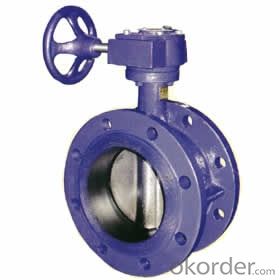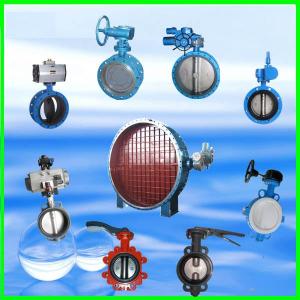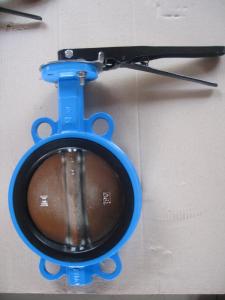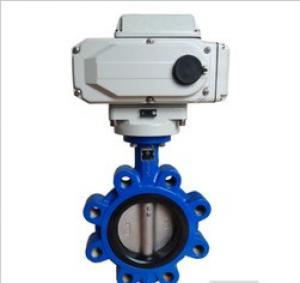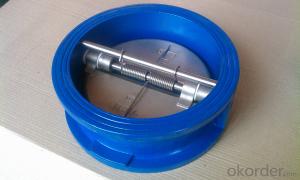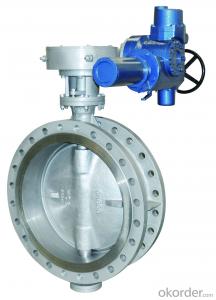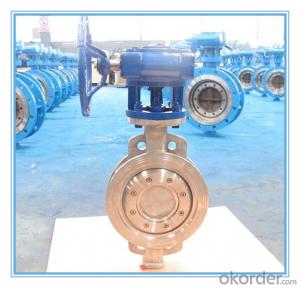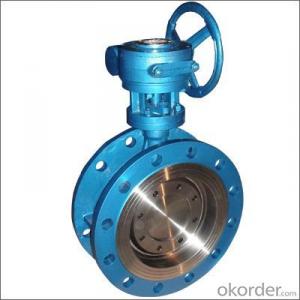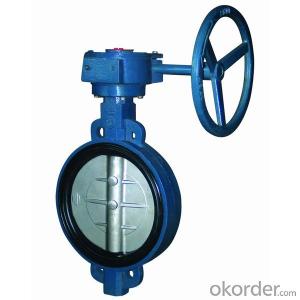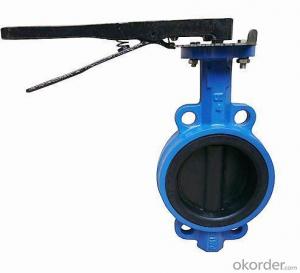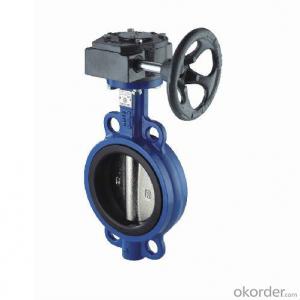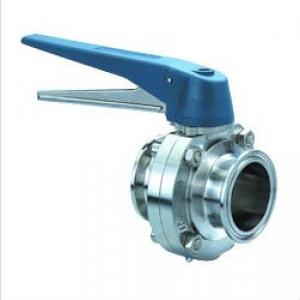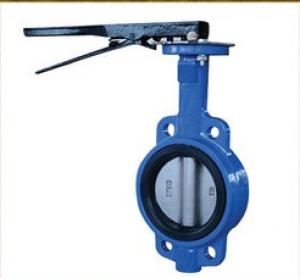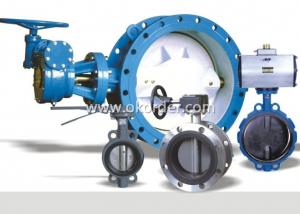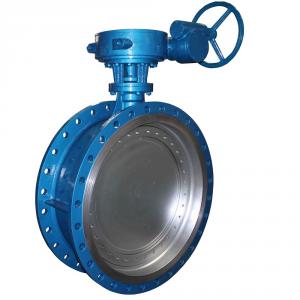Ductile Iron wafer butterfly valves DN330
- Loading Port:
- Tianjin
- Payment Terms:
- TT OR LC
- Min Order Qty:
- 100 set
- Supply Capability:
- 80000 set/month
OKorder Service Pledge
OKorder Financial Service
You Might Also Like
A butterfly valve consists of body ,stem ,disc , actuator (manual actuator, worm-gear actuator , aerodynamic actuator or electric actuator) , and wafer type butterfly valve can implement the process for turning on turning off and regulating the flow by the circumrotation of stem and disc that is droved by actuators.
1.Simple and compact construction. Small in size and light in weight. Easy transportation, installation and maintenance.
2. Quick 90 degrees on-off operation. Minimized operating torque ,energy saving.
3. Excellent sealing performance with no leakage. Long service life.
4. Wide selection of materials ,applicable for various media..
5. Flow curve tending to straight line. Excellent regulation performance.
- Q: Transformer butterfly valve and pressure relief valve difference
- The butterfly valve is usually fitted with an oil immersed transformer between the tank and the radiator to control the flow of oil between the transformer tank and the heat sink. When large power transformers are delivered, the radiators are usually individually packed to reduce transport sizes. The butterfly valve is closed to prevent the outside air or water from entering the transformer tank. When the transformer is transported to the installation site, the radiator is installed on the butterfly valve one by one. When the radiator is installed, the butterfly valve can be opened so that the oil flow between the transformer, the oil tank and the radiator can be circulated, so as to play the role of heat dissipation.When the transformer is running, it is found that when the radiator has seepage, the butterfly valve can be closed to avoid further leakage of transformer oil, and a new radiator can be replaced.
- Q: For whatever reason, Mazda has made it next to impossible to change the PCV valve on the 929. I'm going to have to pull off the plenum and the passenger's side valve cover to replace a $2.00 PCV valve. Before I get too involved, I need to know the torque specs for the valve cover. Also, any other tips on this process would be greatly appreciated. Can I reuse the old valve cover gasket if it's still in good shape? Should I use any kind of sealant in addition to the gasket when I put it all back together? Thanks in advance, by looking at this motor, I can tell I'll have my work cut out for me (for a friggin $2.00 PCV valve, it's usually SO simple!). Like I said, any and all help is greatly appreciated.
- you do not torque valve covers down, buy a new gasket , I would get a good quality rubber one and some blue rtv sealer, clean any crap off the valve cover no glue no bits of gasket nothing, same thing on the head surface, glue the gasket on the valve cover, let it set, then carefully put it on, start with the bolts in the middle and work out finger tight all of them, then just snug the bolts down, dont crush the gasket, you can also use a light duty locktite to hold them in place, and often times old valve covers are warped, it is too your advantage to make sure its as flat as you can get it, or spend a few bucks a buy a new one. your choice, but snug the nuts down good with out crushing and bending the thin sheet metal of the valve cover.
- Q: How do i use a valve spring compressor. It looks like a c-clamp, so don't tell me how to use a smaller one, but the bigger one.Thanks
- The forked end goes over the valve retainer, the flat end with the screw goes against the valve face. Simply close the handle to compress the spring. You may need to adjust the width of the jaws to fit the retainer and adjust the length of the screw to compress the spring the right amount. Sometimes it helps to gently tap the edge of the retainer with a hammer to loosen the keepers before compressing the spring.
- Q: Function of signal butterfly valve in fire sprinkler system
- The signal butterfly valve is generally installed in two parts: floor level, dry pipe, flow indicator front end, trunk pipe, wet alarm valve, front end.Floor level pipe installation is a function of the signal valve, when the floor spraying system needs repair, close the valve, open the end of the floor drain, emptying the water in the spray system, maintenance; two is the sprinkler system is not allowed inside water, when the butterfly is closed, will transmit a signal to the the fire alarm system, fire alarm system receives a monitoring signal (so called signal butterfly valve), fire sprinkler system that the floor is anhydrous state, fast repair.Wet alarm valve at the front of the signal butterfly valve with the main floor of the main role of the butterfly valve, first, maintenance, and two is the prompt sprinkler system, there is a signal butterfly valve closed, should be repaired as soon as possible.
- Q: What are the major disadvantages of butterfly valves?
- Rubber elastomer in the butterfly valve will cause tear, wear, aging, perforation and even shedding in continuous use. The traditional heat curing process is difficult to adapt to the needs of on-site repair. It is time-consuming and laborious to use special equipment when repairing, and it consumes a lot of heat and electricity. Nowadays, polymer composite method is gradually used instead of traditional method.
- Q: How does the pneumatic butterfly valve control the angle of opening?
- The angle of the rotating shaft is controlled so that the angle of the butterfly valve is controlled. You just have a good electrical locator
- Q: Is the pressure test of the centerline butterfly valve checked or checked?
- The pressure test of the central butterfly valve is carried out at each station.Basis:1) GB/T12238-2008 flange and clamp connection elastic seal butterfly valveRules: butterfly valve must be carried out by factory inspection and testing, inspection qualified before leaving the factory.2) CJ/T 261-2007, butterfly valves for water supply and drainageRules: each product shall be inspected by factory and quality inspection department. After inspection, the product certificate shall be attached to the factory.Butterfly: also known as butterfly valve, control valve has a simple structure, can be used for low pressure pipeline valve switching control is closed parts (disc or disc) is a disk, around the valve axis to achieve the opening and closing a valve, the valve can be used to control air, water, steam, all kinds of corrosive media, mud, oil, metals and radioactive liquid media and other types of fluid flow. On the pipeline, mainly from cutting and throttling. Butterfly valve headstock is a disc shaped disc, in the valve body around its own axis of rotation, so as to achieve the purpose of opening or closing or regulation.
- Q: Butterfly valve switch direction respectively?
- If there is no arrow on the handwheel, the indicator on the turbine has been damaged, you can put your ear on the wall of the pipe, turn the handwheel, and through the sound of the pipe medium to determine the direction of the switch.
- Q: DN80 flange butterfly valve, DN80 flange butterfly valve DN80, flange butterfly valve DN80 what is the difference?
- Of course there are differences, the general market sales of the DN80 are many flange plate copper rod butterfly valve, quality can not reach the national standard, to use copper rod copper butterfly valve quality is king.
- Q: I need a valve cover gasket replacement because mine is leaking a tremendous amount of oil. The mechanic says it will cost about $269.00 plus tax. I wanted to make sure this figure was the average since I do not know a lot about cars. My car is a Mitsubishi Diamante 2001.
- The gasket set is probably $ 20, so double that to $ 40..... 270 - 40 is 230, divided by 2 man-hours, which is the usually dealership minimum, gives $ 115 an hour. I DON'T THINK SO !!!! Unless you live in Hawaii where everything is expensive, that sounds steep.... real steep. Dealers around here get like $ 85 an hour, so two hours is 170, plus 40 is 210 bucks; Still killer money for the dealer..... I'd question that estimate ask if there is some extraordinary challenge to working on your car. It is possible there are accessories mounted over the valve cover that will have to be moved, or that's it's a canted V-6 with one valve cover tucked up against the fire wall. Be nice, smile, ask questions.... Maybe even have someone show you what has to be moved on your engine to get at the valve cover(s). If you're going to pay that much $$$, you should learn something, also.
Send your message to us
Ductile Iron wafer butterfly valves DN330
- Loading Port:
- Tianjin
- Payment Terms:
- TT OR LC
- Min Order Qty:
- 100 set
- Supply Capability:
- 80000 set/month
OKorder Service Pledge
OKorder Financial Service
Similar products
Hot products
Hot Searches
Related keywords

